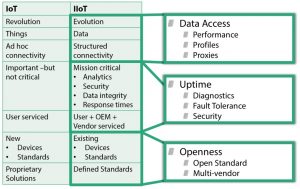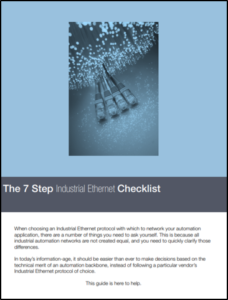PROFINET is foundational to the Industrial Internet of Things (IIoT) which lies in the overlap of the Internet of Things (IoT) and Industrie 4.0. There are differences between IoT and IIoT. This is the second of three lessons that will extend that into the PROFINET of Things. Not just any Industrial Ethernet can claim to be foundational to IIoT; here are the benefits of PROFINET that differentiate it from the others – all in the context of the IIoT characteristics.
A major driving force of the Industrial Internet of Things and Industrie 4.0 is the reliance on open standards. PROFINET devices are manufactured according to the PROFINET specification (IEC 61158). PROFINET is Ethernet, IEEE 802.3. Many other standards also come into play – standards from IEC, IEEE, NAMUR, and IETF (Internet Engineering task Force):
- IEC 61784
- IEC 61508
- IEC 61784-3-3
- IEEE 802.11 (b, g, a, h, n, ac)
- IEEE 802.15.1
- IEEE 802.1AB
- RFC 1155
- RFC 1213
- RFC 1157
- and many more
There are other Industrial Ethernets that are “open,” but they are not as open as PROFINET; for example, EtherNet/IP requires a signed contract with ODVA and EtherCAT’s intellectual property and logo are owned by one company. For more details, see the PROFIblog post “Open Standards, Proprietary Standards, and in Between.”
One challenge for the IIoT is accessing devices that do not have an IP address. Some devices are just too simple and inexpensive to have any electronics in them. A mechanical limit switch can connect to PROFINET I/O, so no difficulty there. But what about devices that do have electronics, but no Ethernet controller? Devices connected to legacy networks fall into this category. PROFINET addresses this as part of the PROFINET specification! Using proxies which have standardized, specified data mapping, PROFINET integrates PROFIBUS DP, PROFIBUS PA, Interbus, DeviceNet, Foundation Fieldbus, and many others. This open specification approach to non-Ethernet networks is a PROFINET exclusive.
The user benefits from open standards with longer supported lifetimes compared to proprietary standards. And having multiple vendors competing for their business helps keep pricing competitive.
PROFINET of Things: Openness continues the tradition of multi-vendor cooperation in developing the standard and multi-vendor competition for users’ business. And with PROFINET this openness extends down to non-Ethernet devices.)
For further study:
PROFINET of Things white paper covering all three lessons.
PROFINEWS article, PROFINET of Things – Explained.
PROFIblog post “Open Standards, Proprietary Standards, and in Between.”

